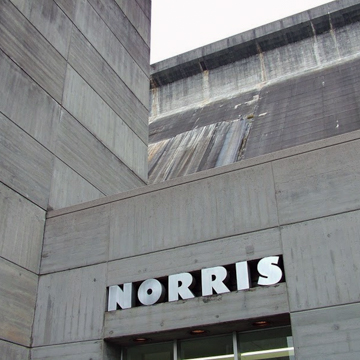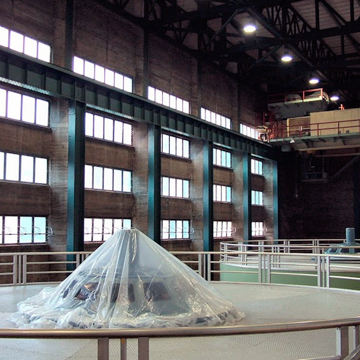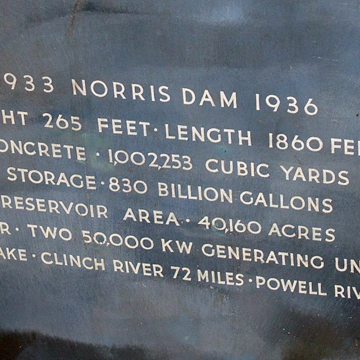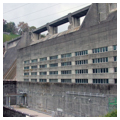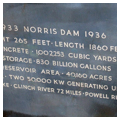The Tennessee Valley Authority (TVA), a New Deal agency, was formed in 1933 with a directive to manage the 900 miles of the Tennessee River basin that traversed seven states. The legislation creating the agency allowed it to improve flood control and navigation; generate electric power; establish or improve recreation areas, roads, and communities; and initiate other projects that would better the social and economic well-being of the region. Norris Dam, built between 1933 and 1936, was the new agency’s first hydroelectric project and it would serve as a prototype for numerous others the TVA undertook. It was named in honor of Senator George Norris (1861–1944) of Nebraska, a passionate advocate of the TVA.
Located on the Clinch River in East Tennessee, the Norris hydroelectric project included the dam, powerhouse, and switchyard. There was little in the way of housing in the area and a TVA headquarters was in Knoxville, nearly forty miles away, so the project included the planned community of Norris and the Norris Freeway. The project brought employment, schools, housing, and electricity to an economically devastated part of Appalachia but it was not without controversy, since approximately 3,000 people were displaced from 152,000 acres.
The design of Norris Dam fell to a team of architects headed by Roland Wank, a Hungarian-born modernist designer recruited as TVA’s first chief architect in 1933. Prior to this project, dam builders were concerned primarily with engineering, but Wank and his team viewed the Norris Dam as civic project as well, one requiring a visitor’s center, signs, and circulation paths for cars and people. The dam itself was designed as a straight gravity concrete structure, 265 feet tall (the equivalent of a 24-story building) and 1,860 feet long. When the project’s more than a million cubic yards of concrete finally set, the system was able to store 830 billion gallons of water. The powerhouse located on the east side of the river was equipped with two 50,000 kilowatt generators. As in all of TVA’s early hydroelectric projects, a plaque on the powerhouse indicates that the dam was “Built for the People of the United States of America.”
Both the powerhouse and dam itself are powerful expressions of reinforced concrete, which the TVA architects left unfinished to reveal the alternating pattern of vertical and horizontal boards used for the formwork. During a visit to the dam in 1946, Le Corbusier admired the frank handling of the concrete and he adopted a similar treatment of what became known as béton brut for his famous Unité d’Habitation housing project in Marseille, begun in 1947.
The large expanse of concrete of the Norris Dam was broken up by the bold inset aluminum “Norris” sign at the entry to the visitor's center and by the banks of windows of the powerhouse. Inside the powerhouse are glazed tiles and curved aluminum railings that add to the streamlined effect of the complex.
Norris Dam has changed little since construction. It is still in use, though public access is now limited. In 1948, TVA sold the nearby town of Norris to private owners. Visitors can see the original 544-seat cafeteria, community center, school, gas stations, eight dormitories, and over 300 houses.
References
Bacon, Mardges, “Le Corbusier and Postwar America: The TVA and Béton Brut.” Journal of the Society of Architectural Historians 74 no. 1 (March 2015): 13-40.
Cutler, Phoebe. The Public Landscape of the New Deal. New Haven CT: Yale University Press, 1985.
Ezzell, Patricia Bernard. TVA Photography: Thirty Years of Life in the Tennessee Valley. Jackson MS: University Press of Mississippi, 2003.
Kowelczyk, Andra, and Phil Thomason, “Norris Hydroelectric Project,” Anderson County, Tennessee. National Register of Historic Places Registration Form, 2016. National Park Service, U.S. Department of the Interior, Washington D.C.
Minton, John Dean. The New Deal in Tennessee: 1932–1938. New York: Garland Publishing, Inc., 1979.
Moffett, Marian. “Looking to the Future: The Architecture of Roland Wank.” Arris: Journal of the Southeast Chapter of the Society of Architectural Historians 1 (1989): 5-18.
Schaffer, Daniel, “Norris Dam,” Anderson County, Tennessee. National Register of Historic Places Inventory–Nomination Form (draft), 1981. Tennessee Historical Commission files, Nashville, Tennessee.
“TVA: Electricity for All.” New Deal Network. Accessed March 29, 2018. http://newdeal.feri.org.
“TVA Heritage.” Tennessee Valley Authority. Accessed March 29, 2018. http://www.tva.gov/.
United States Tennessee Valley Authority. The Norris Project: A Comprehensive Report on the Planning, Design, Construction and Initial Operations of the Tennessee Valley Authority’s First Water Control Project. Technical Report No. 1. Washington DC: United States Government Printing Office, 1940.















